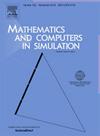Numerical analysis of linearly implicit Milstein method for stochastic SEIR models with nonlinear incidence rates
IF 4.4
2区 数学
Q1 COMPUTER SCIENCE, INTERDISCIPLINARY APPLICATIONS
引用次数: 0
Abstract
In this paper, we focus on the numerical analysis of stochastic SEIR models with nonlinear incidence rates. By reformulating the stochastic basic reproduction number , it is shown that the disease extinction of deterministic models is preserved under stochastic noises. On the other hand, the total population of stochastic SEIR models is varying and even unbounded when there are some noises in the natural death rate. Therefore, as the fundamental approach, we have to present the boundedness in the 4th moment and Hölder continuity of the exact solutions for the numerical convergence analysis. Numerically, a linearly implicit Milstein method is employed to ensure the numerical positivity under the condition of and hence the numerical boundedness is obtained in the 4th moment. After the strong convergence analysis under the fundamental theory, we are much more interested in the numerical dynamic behaviors. Since the previous technique, the exponent representation of the stability function, is not available for the higher dimensional models, a logarithmic martingale estimation to the numerical disease is introduced in this paper, and hence the numerical replications of the long-time dynamic behaviors are discussed thoroughly. Finally, some numerical experiments are provided to verify the theoretical analysis and illustrate the convergence analysis of the numerical steady distribution in the future.
非线性发生率随机SEIR模型线性隐式Milstein方法的数值分析
本文主要研究具有非线性发生率的随机SEIR模型的数值分析。通过对随机基本再现数R0S的重新表述,证明了确定性模型在随机噪声下保持疾病消光。另一方面,当自然死亡率中存在噪声时,随机SEIR模型的总体是变化的,甚至是无界的。因此,作为基本的方法,我们必须提出第四阶矩的有界性和Hölder精确解的连续性来进行数值收敛分析。在数值上,采用线性隐式Milstein方法保证了h<;h0条件下的数值正性,从而在第4阶矩处得到数值有界性。在基础理论的强收敛性分析之后,我们对数值动力学行为更感兴趣。由于以前的方法,即稳定性函数的指数表示,不能用于高维模型,本文引入了对数值疾病的对数鞅估计,从而深入讨论了长时间动态行为的数值复制。最后,通过数值实验验证了理论分析的正确性,说明了数值稳定分布的收敛性分析。
本文章由计算机程序翻译,如有差异,请以英文原文为准。
求助全文
约1分钟内获得全文
求助全文
来源期刊

Mathematics and Computers in Simulation
数学-计算机:跨学科应用
CiteScore
8.90
自引率
4.30%
发文量
335
审稿时长
54 days
期刊介绍:
The aim of the journal is to provide an international forum for the dissemination of up-to-date information in the fields of the mathematics and computers, in particular (but not exclusively) as they apply to the dynamics of systems, their simulation and scientific computation in general. Published material ranges from short, concise research papers to more general tutorial articles.
Mathematics and Computers in Simulation, published monthly, is the official organ of IMACS, the International Association for Mathematics and Computers in Simulation (Formerly AICA). This Association, founded in 1955 and legally incorporated in 1956 is a member of FIACC (the Five International Associations Coordinating Committee), together with IFIP, IFAV, IFORS and IMEKO.
Topics covered by the journal include mathematical tools in:
•The foundations of systems modelling
•Numerical analysis and the development of algorithms for simulation
They also include considerations about computer hardware for simulation and about special software and compilers.
The journal also publishes articles concerned with specific applications of modelling and simulation in science and engineering, with relevant applied mathematics, the general philosophy of systems simulation, and their impact on disciplinary and interdisciplinary research.
The journal includes a Book Review section -- and a "News on IMACS" section that contains a Calendar of future Conferences/Events and other information about the Association.
 求助内容:
求助内容: 应助结果提醒方式:
应助结果提醒方式:


